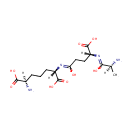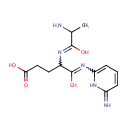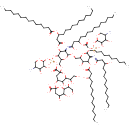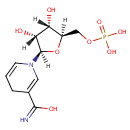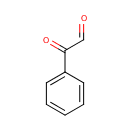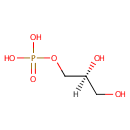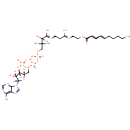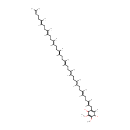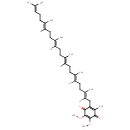
Search Results for compounds
Searching compounds for
returned 4373 results.
L-Ala-D-Glu-meso-A2pm (PAMDB001376)
IUPAC:
(2R,6S)-2-amino-6-{[(4R)-4-{[(2S)-2-amino-1-hydroxypropylidene]amino}-4-carboxy-1-hydroxybutylidene]amino}heptanedioic acid
CAS: Not Available
Description: L-ala-D-glu-meso-a2pm is a member of the chemical class known as Peptides. These are compounds containing an amide derived from two or more amino carboxylic acid molecules (the same or different) by formation of a covalent bond from the carbonyl carbon of one to the nitrogen atom of another.
L-Ala-gamma-D-Glu-Dap (PAMDB001378)
IUPAC:
4-[(2-amino-1-hydroxypropylidene)amino]-4-[(6-imino-1,6-dihydropyridin-2-yl)-C-hydroxycarbonimidoyl]butanoic acid
CAS: Not Available
Description: L-ala-gamma-D-glu-DAP is a member of the chemical class known as Hybrid Peptides. These are compounds containing at least two different types of amino acids (alpha, beta, gamma, delta). L-alanyl-gamma-D-glutamyl-meso-diaminopimelate is related to MppA. MppA is a periplasmic binding protein in Pseudomonas aeruginosa essential for uptake of the cell wall murein tripeptide L-alanyl-gamma-D-glutamyl-meso-diaminopimelate. (PMID 10438753)
L-Ara4N-modified KDO2-Lipid A (PAMDB001379)
IUPAC:
2-{[3-({[(5-amino-3,4-dihydroxyoxan-2-yl)oxy](hydroxy)phosphoryl}oxy)-6-{[6-({[(5-amino-3,4-dihydroxyoxan-2-yl)oxy](hydroxy)phosphoryl}oxy)-5-[(1,3-dihydroxytetradecylidene)amino]-3-hydroxy-4-[(3-hydroxytetradecanoyl)oxy]oxan-2-yl]methoxy}-5-{[3-(dodecanoyloxy)-1-hydroxytetradecylidene]amino}-4-{[3-(tetradecanoyloxy)tetradecanoyl]oxy}oxan-2-yl]methoxy}-4-{[2-carboxy-6-(1,2-dihydroxyethyl)-4,5-dihydroxyoxan-2-yl]oxy}-6-(1,2-dihydroxyethyl)-5-hydroxyoxane-2-carboxylic acid
CAS: Not Available
Description: L-ara4n-modified kdo2-lipid a is a member of the chemical class known as Hexose Oligosaccharides. These are oligosaccharides in which the saccharide units are hexoses.
NMNH (PAMDB001395)
IUPAC:
1-[(2R,3R,4S,5R)-3,4-dihydroxy-5-[(phosphonooxy)methyl]oxolan-2-yl]-1,4-dihydropyridine-3-carboximidic acid
CAS: Not Available
Description: NMNH is a member of the chemical class known as Nicotinamide Nucleotides. These are pyridine nucleotides, in which the pyridine base is nicotinamide or a derivative thereof.
Phenylglyoxal (PAMDB001398)
IUPAC:
2-oxo-2-phenylacetaldehyde
CAS: 1074-12-0
Description: Phenylglyoxal is a member of the chemical class known as Phenylacetaldehydes. These are compounds containing a phenylacetaldehyde moiety, which consists of a phenyl group substituted at the second position by an acetalydehyde. It contains both an aldehyde and a ketone functional group. It is yellow liquid when anhydrous but readily forms a colorless crystalline hydrate. It has been used as a reagent to modify the amino acid, arginine. It is a substrate for the enzyme HcHA or Glyoxylse III. This enzyme catalyzes the conversion of methylglyoxal (MG) to D-lactate in a single glutathione (GSH)-independent step. It can also use phenylglyoxal as substrate and generate phenylactate.
Cyclic pyranopterin monophosphate (PAMDB001401)
IUPAC:
(4aR,5aR,11aR,12aS)-2,10,12,12-tetrahydroxy-8-imino-4,4a,5a,6,7,8,11,11a,12,12a-decahydro-2H-1,3,5-trioxa-6,7,9,11-tetraaza-2???phosphatetracen-2-one
CAS: Not Available
Description: Cyclic pyranopterin monophosphate is a member of the chemical class known as Pterins and Derivatives. These are polycyclic aromatic compounds containing a pterin moeity, which consist of a pteridine ring bearing a ketone and an amine group to form 2-aminopteridin-4(3H)-one. cPMP is a precursor to molybdenum cofactor, which is required for the enyzme activity of sulfite oxidase, xanthine dehydrogenase/oxidase and aldehyde oxidase. The transition element molybdenum (Mo) has been long known as an essential micronutrient across the kingdoms of plants, animals, fungi and bacteria. However, molybdate itself is catalytically inactive and, with the exception of bacterial nitrogenase, needs to be activated through complexation by a special cofactor. There are several molybdenum cofactors, including molybdopterin (MPT), guanylyl molybdenum cofactor (MGD), cytidylyl molybdenum cofactor, or others. In Pseudomonas aeruginosa, the MoaD protein plays a central role in the conversion of precursor Z to molybdopterin (MPT) during molybdenum cofactor biosynthesis. (PMID 17223713) In Pseudomonas aeruginosa, MPT is formed by incorporation of two sulfur atoms into precursor Z, which is catalyzed by MPT synthase. (PMID 11459846)
Sn-Glycerol-1-phosphate (PAMDB001409)
IUPAC:
[(2S)-2,3-dihydroxypropoxy]phosphonic acid
CAS: 5746-57-6
Description: Sn-glycerol-1-phosphate is a glycerol phosphate. It is a key substrate in phospholipid synthesis and phosphatidylglycerol sbiosynthesis. The sn-glycerol-3-phosphate acyltransferase (plsB) of Pseudomonas aeruginosa is a key regulatory enzyme that catalyzes the first committed step in phospholipid biosynthesis. (PMID 9393688) Fosmidomycin is a hydrophilic molecule and in many bacteria its uptake is an active process involving a cAMP dependent glycerol-3-phosphate transporter (GlpT). (PMID 18489786)
trans-Delta2, cis-delta4-decadienoyl-CoA (PAMDB001410)
IUPAC:
4-({[({[(2S,3S,4R,5S)-5-(6-amino-9H-purin-9-yl)-4-hydroxy-3-(phosphonooxy)oxolan-2-yl]methoxy}(hydroxy)phosphoryl)oxy](hydroxy)phosphoryl}oxy)-N-(2-{[2-(deca-2,4-dienoylsulfanyl)ethyl]-C-hydroxycarbonimidoyl}ethyl)-2-hydroxy-3,3-dimethylbutanimidic acid
CAS: Not Available
Description: Trans-delta2, cis-delta4-decadienoyl-coa belongs to the class of Coenzyme A and Derivatives. These are derivative of vitamin B5 containing a 4'-phosphopantetheine moiety attached to a diphospho-adenosine. (inferred from compound structure)
Ubiquinol-10 (PAMDB001417)
IUPAC:
2-[(2E,6E,10E,14E,18E,22E,26E,30E,34E)-3,7,11,15,19,23,27,31,35,39-decamethyltetraconta-2,6,10,14,18,22,26,30,34,38-decaen-1-yl]-5,6-dimethoxy-3-methylcyclohexa-2,5-diene-1,4-diol
CAS: 5677-55-4
Description: Ubiquinol-10 is a member of the chemical class known as Polyprenylbenzoquinols. They are reduced forms of polyprenylbenzoquinines (ubiquinones). These are compounds containing a polyisoprene chain attached to a quinol at the second ring position. Ubiquiol-10 has 10 isoprene units. Normally in Pseudomonas aeruginosa the active form of Ubiquinol has 8 isoprene units (Ubiquinol-8) and in humans it normally has 10. Ubiquinol-10 is an extended version of Ubiquinol 8 that arises from conjugation by an extended prenyl tail via 4-hydroxybenzoate polyprenyltransferase. Coenzyme Q(n) exists in three redox states, fully oxidized (ubiquinone), partially reduced (semiquinones or ubisemiquinones), and fully reduced (ubiquinols). The redox functions of ubiquinol in cellular energy production and antioxidant protection are based on the ability to exchange two electrons in a redox cycle between ubiquinol (reduced) and the ubiquinone (oxidized) form. Ubiquionols are important in cellular respiration. They are fat-soluble and therefore mobile in cellular membranes; they play a unique role in the electron transport chain (ETC). In the inner bacterial membrane, electrons from NADH and succinate pass through the ETC to the oxygen, which is then reduced to water. The transfer of electrons through ETC results in the pumping of H+ across the membrane creating a proton gradient across the membrane, which is used by ATP synthase (located on the membrane) to generate ATP.
Ubiquinone-6 (PAMDB001418)
IUPAC:
2-[(2E,6E,10E,14E,18E)-3,7,11,15,19,23-hexamethyltetracosa-2,6,10,14,18,22-hexaen-1-yl]-5,6-dimethoxy-3-methylcyclohexa-2,5-diene-1,4-dione
CAS: 1065-31-2
Description: Ubiquinone-6 is a member of the chemical class known as Polyprenylbenzoquinones. These are compounds containing a polyisoprene chain attached to a quinone at the second ring position. Ubiquione-6 has just 6 isoprene units. Normally in Pseudomonas aeruginosa the active form of Ubiquinone has 8 isoprene units (Ubiquinone-8) and in humans it normally has 10. Ubiquinone-6 is a ??ailed??or incomplete version of Ubiquinone 8 that arises from conjugation by a shortened prenyl tail via 4-hydroxybenzoate polyprenyltransferase. Ubiquionone is involved in cellular respiration. It is fat-soluble and is therefore mobile in cellular membranes; it plays a unique role in the electron transport chain (ETC). In the inner bacterial membrane, electrons from NADH and succinate pass through the ETC to the oxygen, which is then reduced to water. The transfer of electrons through ETC results in the pumping of H+ across the membrane creating a proton gradient across the membrane, which is used by ATP synthase (located on the membrane) to generate ATP.
